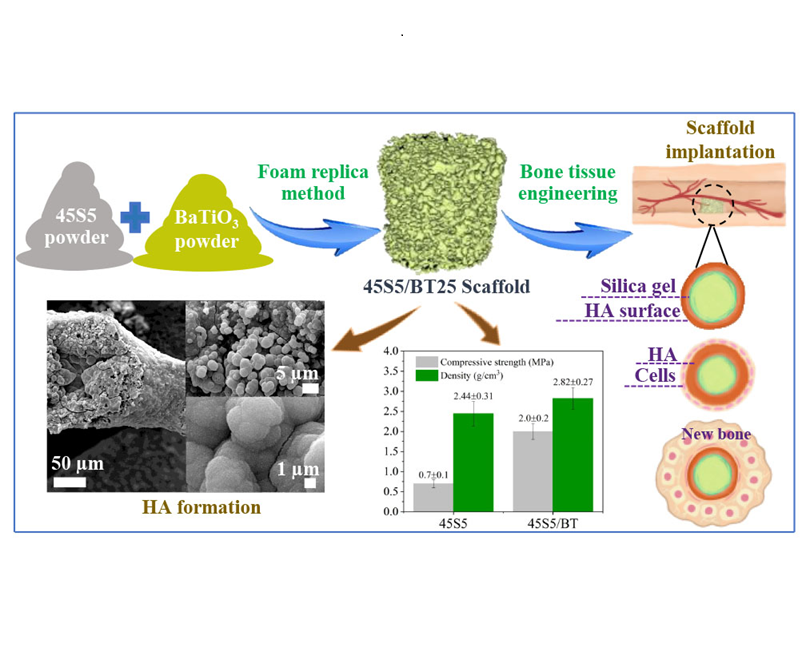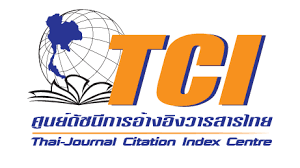Improving the mechanical performance of 45S5 3D scaffolds through the particles of barium titanate ceramics
DOI:
https://doi.org/10.55713/jmmm.v35i3.2308คำสำคัญ:
Bioactive glass, Barium titanate, Scaffold, Bone regenerationบทคัดย่อ
Bioglass® 45S5 is widely used in bone tissue engineering due to its excellent bioactivity. However, its low mechanical strength remains a major limitation. In this study, 25 wt% barium titanate (BaTiO3; BT) was incorporated into 45S5 scaffolds to improve mechanical performance and modulate bioactivity. The 3D scaffolds were fabricated using the foam replication method and exhibited interconnected porosity, with average pore sizes of 471 ± 94 μm (45S5) and 598 ± 58 μm (45S5/BT25), closely resembling human bone. The addition of BT increased the density and compressive strength of the scaffolds to 2.89 ± 0.18 g∙cm‒3 and 2.0 ± 0.2 MPa, respectively. Bioactivity evaluation in simulated body fluid (SBF) revealed delayed carbonated hydroxyapatite (CHA) formation in 45S5/BT25 scaffolds, with CHA detected after 21 days, compared to 7 days in pure 45S5. This delay was consistent with FTIR, SEM-EDS, and XRD results and is likely attributed the formation of a stable Ba2TiSi2O8 phase. Overall, these results indicate that BT-modified 45S5 scaffolds not only exhibit improved mechanical performance but also offer tunable bioactivity, making them promising candidates for tailored bone regeneration applications.
Downloads
เอกสารอ้างอิง
F. Jianqing, Y. Huipin, and Z. Xingdong, “Promotion of osteogenesis by a piezoelectric biological ceramic,” Biomaterials, vol. 18, pp. 1531‒1534, 1997. DOI: https://doi.org/10.1016/S0142-9612(97)80004-X
R. Donate, R. Paz, R. Moriche, M. J. Sayagués, M. E. A. Domínguez, and M. Monzón, “An overview of polymeric composite scaffolds with piezoelectric properties for improved bone regeneration,” Materials & Design, vol. 231, p. 112085, 2023. DOI: https://doi.org/10.1016/j.matdes.2023.112085
S. Shahi, S. Karbasi, T. Ahmadi, F. Naeimi, V. Goodarzi, and S. E. Barough, “Evaluation of physical, mechanical and biological properties of β-tri-calcium phosphate/Poly-3- hydroxybutyrate nano composite scaffold for bone tissue engineering application,” Advanced Performance Materials, vol. 36. pp. 237‒249, 2021. DOI: https://doi.org/10.1080/10667857.2020.1747806
L. Siqueira, R. F. Gouveia, L. Grenho, F. J. Monteiro, M. H. Fernandes, and E. S. Trichês, “Highly porous 45S5 bioglass-derived glass-ceramic scaffolds by gelcasting of foams,” Journal of Materials Science, vol. 53, pp. 10718‒10731, 2018. DOI: https://doi.org/10.1007/s10853-018-2337-x
L. L. Hench, and J. Wilson, An introduction to bioceramics, Advanced series in ceramic, World Scientific Singapore, 1993. DOI: https://doi.org/10.1142/2028
D. Navarro da Rocha, L. de Andrade Gobbo, and M. Henrique Prado da Silva, “Production and characterization of niobate apatite,” Journal of Materials Research and Technology, vol. 2, pp. 24‒29, 2013. DOI: https://doi.org/10.1016/j.jmrt.2013.03.007
A. Kumar, S. Murugavel, A. Aditya, and A. R. Boccaccini, “Mesoporous 45S5 bioactive glass: Synthesis, in vitro dissolution and biominerlization behavior,” Journal of Materials Chemistry B, vol. 44, pp. 1‒44, 2017. DOI: https://doi.org/10.1039/C7TB01738C
L. L. Hench, “Chronology of bioactive glass development and clinical applications,” New Journal of Glass and Ceramics, vol. 3, pp. 67‒73, 2013. DOI: https://doi.org/10.4236/njgc.2013.32011
S. Midha, T. B. Kim, W. Bergh, P. D. Lee, J. R. Jones, and C. A. Mitchell, “Preconditioned 70S30C bioactive glass foams promote osteogenesis in vivo,” Acta Biomaterialia, vol. 9, pp. 9169‒9182, 2013. DOI: https://doi.org/10.1016/j.actbio.2013.07.014
B. Saeidi, M. R. Derakhshandeh, M. D. Chermahini, and A. Doostmohammadi, “Novel porous barium titanate/nano-bioactive glass composite with high piezoelectric coefficient for bone regeneration applications,” Journal of Materials Engineering and Performance, vol. 29, pp. 5420‒5427, 2020. DOI: https://doi.org/10.1007/s11665-020-05016-0
C. Polley, T. Distler, C. Scheufler, R. Detsch, H. Lund, A. Springer, D. Schneidereit, P. Friedrich, and A. R. Boccaccini, “3D printing of piezoelectric and bioactive barium titanate-bioactive glass scaffolds for bone tissue engineering,” Materials Today Bio, vol. 21, p. 100719, 2023. DOI: https://doi.org/10.1016/j.mtbio.2023.100719
H. Shokrollahi, F. Salimi, and A. Doostmohammadi, “The fabrication and characterization of barium titanate/akermanite nano-bio-ceramic with a suitable piezoelectric coefficient for bone defect recovery,” Journal of the Mechanical Behavior of Biomedical Materials, vol. 74, pp. 365‒370, 2017. DOI: https://doi.org/10.1016/j.jmbbm.2017.06.024
A. S. Verma, D. Kumar, and A. K. Dubey, “Antibacterial and cellular response of piezoelectric Na0.5K0.5NbO3 modified 1393 bioactive glass,” Materials Science and Engineering C, vol. 116, p. 111138, 2020. DOI: https://doi.org/10.1016/j.msec.2020.111138
A. K. Dubey, R. Kinoshita, and K. I. Kakimoto, “Piezoelectric sodium potassium niobate mediated improved polarization and in vitro bioactivity of hydroxyapatite,” Royal Society of Chemistry Advances, vol. 5, p. 19638, 2015. DOI: https://doi.org/10.1039/C5RA00771B
J. Park, and R. S. Lakes, Biomaterials: An Introduction, Springer, Berlin, 2007.
Y. Zhang, L. Chen, J. Zeng, K. Zhou, and D. Zhang, “Aligned porous barium titanate/hydroxyapatite composites with high piezoelectric coefficients for bone tissue engineering,” Materials Science and Engineering C, vol. 39, pp. 143‒149, 2014. DOI: https://doi.org/10.1016/j.msec.2014.02.022
Q. Fu, M. N. Rahaman, B. S. Bal, R. F. Brown, and D. E. Day, “Mechanical and in vitro performance of 13-93 bioactive glass scaffolds prepared by a polymer foam replication technique,” Acta Biomaterialia, vol. 4, pp. 1854‒1864, 2008. DOI: https://doi.org/10.1016/j.actbio.2008.04.019
L. Stipniecen, I. Narkevica, M. Sokolova, J. Locs, and J. Ozolins, “Novel scaffolds based on hydroxyapatite/poly(vinyl alcohol) nanocomposite coated porous TiO2 ceramics for bone tissue engineering,” Ceramics International, vol. 42, pp. 1530‒1537, 2016. DOI: https://doi.org/10.1016/j.ceramint.2015.09.101
L. Lefebvre, J. Chevalier, L. Gremillard, R. Zenati, G. Thollet, D. B. Assolant, and A. Govin, “Structural transformations of bioactive glass 45S5 with thermal treatments,” Acta Materialia, vol. 55, pp. 3305‒3313, 2007. DOI: https://doi.org/10.1016/j.actamat.2007.01.029
B. R. Barrioni, A. C. Oliveira, M. D. F. Leite, and M. D. M. Pereira, “Sol-gel-derived manganese-releasing bioactive glass as a therapeutic approach for bone tissue engineering,” Journal of Materials Science, vol. 52, pp. 8904‒8927, 2017. DOI: https://doi.org/10.1007/s10853-017-0944-6
Y. Zhu, and S. Kaskel, “Comparison of the in vitro bioactivity and drug release property of mesoporous bioactive glasses (MBGs) and bioactive glasses (BGs) scaffolds,” Microporous and Mesoporous Materials, vol. 118, pp. 176‒182, 2009. DOI: https://doi.org/10.1016/j.micromeso.2008.08.046
W. Li, H. Wang, Y. Ding, E. C. Scheithauer, O. M. Goudouri, A. Grünewalda, R. Detsch, S. Agarwal, and A. R. Boccaccini, “Antibacterial 45S5 Bioglass® -based scaffolds reinforced with genipin cross-linked gelatin for bone tissue engineering,” Journal of Materials Chemistry B, vol. 3, pp. 3367‒3378, 2015. DOI: https://doi.org/10.1039/C5TB00044K
D. Rohanová, A. R. Boccaccini, D. Horkavcová, P. Bozděchová, P. Bezdička, and M. Častorálová, “Is non-buffered DMEM solution a suitable medium for in vitro bioactivity tests?,” Journal of Materials Chemistry B, vol. 2, pp. 5068‒5076, 2014. DOI: https://doi.org/10.1039/C4TB00187G
A. Ehterami, M. Kazemi, B. Nazari, P. Saraeian, and M. Azami, “Fabrication and characterization of highly porous barium titanate based scaffold coated by Gel/HA nanocomposite with high piezoelectric coefficient for bone tissue engineering applications,” Journal of the Mechanical Behavior of Biomedical Materials, vol. 79, pp. 195‒202, 2018. DOI: https://doi.org/10.1016/j.jmbbm.2017.12.034
D. G. Filip, V. A Surdu, A. V. Paduraru, and E. Andronescu, “Current development in biomaterials-hydroxyapatite and bioglass for applications in biomedical field: A Review,” Journal of Functional Biomaterials, vol. 13, p. 248, 2022. DOI: https://doi.org/10.3390/jfb13040248
S. Chajri, S. Bouhazma, I. Adouar, S. Herradi, M. Khaldi, B. El Bali, and M. Lachkar, “Synthesis, characterization and evaluation of bioactivity of glasses in the CaO-SiO2-P2O5-MgO system with different CaO/MgO ratios,” Journal of Physics: Conference Series, vol. 1292, p. 012013, 2019. DOI: https://doi.org/10.1088/1742-6596/1292/1/012013
L. L. Fiench, and J. Wilson, “Surface-active biomaterials,” Science, vol. 226, pp. 630‒636, 1984. DOI: https://doi.org/10.1126/science.6093253
S. Ferraris, S. Yamaguchi, N. Barbani, M. Cazzola, C. Cristallini, M. Miola, E. Vernè, and S. Spriano, “Bioactive materials: In vitro investigation of different mechanisms of hydroxyapatite precipitation,” Acta Biomaterialia, vol. 102, pp. 468‒480, 2020. DOI: https://doi.org/10.1016/j.actbio.2019.11.024
Z. LeGeros, “Properties of osteoconductive biomaterials: calcium phosphates,” Clinical Orthopaedics and Related Research, vol. 395, pp. 81‒98, 2002. DOI: https://doi.org/10.1097/00003086-200202000-00009
P. K. Chakraborty, J. Adhikari, and P. Saha, “Variation of the properties of sol-gel synthesized bioactive glass 45S5 in organic and inorganic acid catalysts,” Materials Advances, vol. 2, pp. 413‒425, 2021. DOI: https://doi.org/10.1039/D0MA00628A
A. K. Dubey, G. Thrivikraman, and B. Basu, “Absence of systemic toxicity in mouse model towards BaTiO3 nanoparticulate based eluate treatment,” Journal of Materials Science: Materials in Medicine, vol. 26, p. 103, 2015. DOI: https://doi.org/10.1007/s10856-015-5414-6
F. Baino, and E. Fiume, “Mechanical characterization of 45S5 bioactive glass-derived scaffolds,” Materials Letters, vol. 245, pp. 14‒17, 2019. DOI: https://doi.org/10.1016/j.matlet.2019.02.086
L. C. Gerhardt, and A. R. Boccaccini, “Bioactive glass and glass-ceramic scaffolds for bone tissue engineering,” Materials, vol. 3, pp. 3867‒3910, 2010. DOI: https://doi.org/10.3390/ma3073867
T. M. Keaveny, E. F. Morgan, G. L. Niebur, and O. C. Yeh, “Biomechanics of trabecular bone,” Annual Review of Biomedical Engineering, vol. 3, pp. 307‒333, 2001. DOI: https://doi.org/10.1146/annurev.bioeng.3.1.307
T. A. Einhorn, and L. C. Gerstenfeld, “Fracture healing: Mechanisms and interventions,” Nature Reviews Rheumatology, vol. 11, pp. 45‒54, 2015. DOI: https://doi.org/10.1038/nrrheum.2014.164
A. N. Nomm, L. Hupa, D. Rohanová, and D. S. Brauer, “A review of acellular immersion tests on bioactive glasses-influence of medium on ion release and apatite formation,” International Journal of Applied Glass Science, vol. 11, pp. 537‒551, 2020. DOI: https://doi.org/10.1111/ijag.15006
Y. Tang, C. Wu, Z. Wu, L. Hu, W. Zhang, and K. Zhao, “Fabrication and in vitro biological properties of piezoelectric bioceramics for bone regeneration,” Scientific Reports, vol. 7, p. 43360, 2017. DOI: https://doi.org/10.1038/srep43360
H. Huang, K. Wang, X. Liu, X. Liu, J. Wang, M. Suo, H. Wang, S. Chen, X. Chen. and Z. Li, “Piezoelectric biomaterials for providing electrical stimulation in bone tissue engineering: Barium titanate,” Journal of Orthopaedic Translation, vol. 51, pp. 94‒107, 2025. DOI: https://doi.org/10.1016/j.jot.2024.12.011

ดาวน์โหลด
เผยแพร่แล้ว
วิธีการอ้างอิง
ฉบับ
บท
Categories
การอนุญาต
ลิขสิทธิ์ (c) 2025 วารสารโลหะ, วัสดุ และแร่

This work is licensed under a Creative Commons Attribution-NonCommercial-NoDerivatives 4.0 International License.
Authors who publish in this journal agree to the following terms:
- Authors retain copyright and grant the journal right of first publication with the work simultaneously licensed under a Creative Commons Attribution License that allows others to share the work with an acknowledgment of the work's authorship and initial publication in this journal.
- Authors are able to enter into separate, additional contractual arrangements for the non-exclusive distribution of the journal's published version of the work (e.g., post it to an institutional repository or publish it in a book), with an acknowledgment of its initial publication in this journal.












